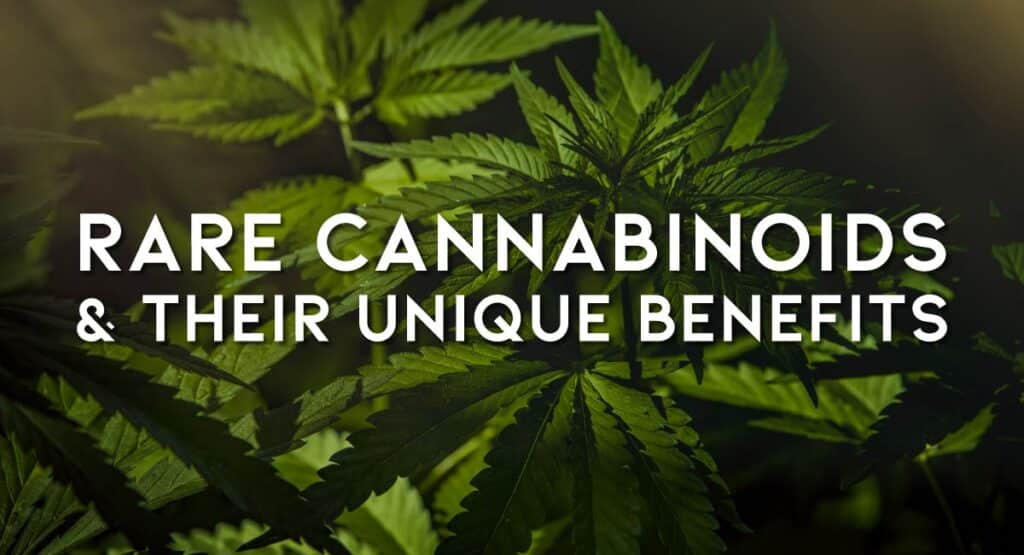Ten years ago, the term ‘cannabinoid’ wasn’t widely used. Even folks in the cannabis industry tread lightly with how to use the term in sales and marketing to help consumers understand the chemical makeup of marijuana. Yet, this lingo became more readily adopted over time, and the market was prepared for more. Terpenes, sativa, indica, and hybrid were all added to the connoisseur’s cannabis glossary.
Cannabinoids hold the potential to shift the medical landscape massively, and ongoing research is exciting and promising. Every day, lives are changed by the addition of cannabinoids to wellness routines and recreational pursuits. Still, we only talk about a couple of the major players, and many more rare cannabinoids deserve equal attention.
What Are Cannabinoids?
Cannabinoids are the active compounds in cannabis. Well, the most active, that is. There are also terpenes, but for this article, we’ll be focusing on cannabinoids. There are well over 100 cannabinoids found in cannabis, and many of them are considered rare cannabinoids.
The human body contains an endocannabinoid system with receptor points designed to interact with cannabinoids. In fact, we actually produce our own cannabinoids that fit like locks and keys into these receptors to modulate bodily functions. Without cannabinoids, we fall out of homeostasis.
The ones we produce internally are called endocannabinoids, and those found in marijuana are called phytocannabinoids. We tend to refer to both as cannabinoids for simplicity. When the human body is out of balance, cannabinoids from cannabis help us find homeostasis again. It is possible to have an endocannabinoid deficiency, which is when illness and disease are present. It can manifest as digestive issues, sleep trouble, chronic pain, and hormonal imbalances.
Adding cannabis-derived cannabinoids can bring you back to homeostasis. This is, of course, the basis and case for medical marijuana. The very notion that we have an entire system within us that wants to synergize with cannabinoids is pretty remarkable. The human body was literally designed to assimilate cannabinoids. So, which ones do we need, and what do they do?
Most Abundant Cannabinoids
Before we dig into the rare cannabinoids, let’s first look at the most abundant cannabinoids.
THC – Tetrahydrocannabinol
By far, the most well-known, understood, and sought-after cannabinoid is Delta-9 THC or Δ-9THC. It’s the cannabinoid that gets you high, lifted, stoned, medicated, ripped, baked, bombed, or buzzed. It’s the one everyone knows, and it’s basically synonymous with “weed.”
THC is psychoactive, meaning it affects the mind and may produce psychedelic effects in large doses. Its potency varies from plant to extract; you can find it in any concentration or form factor you like. THC is the OG cannabinoid, and it’s a household name.
THC boasts several medical, therapeutic, and recreational benefits. It increases feelings of happiness and euphoria, which can also alleviate symptoms of depression and reduce anxiety. THC is incredible at treating pain, reducing nausea, relieving muscle spasms, increasing appetite (hello munchies), and many more things related to the nervous system.
Note: THCa is an abundant cannabinoid, but it’s important to explain this. The ‘a’ refers to an acid. Once this acid is properly heated – a process called decarboxylation – the ‘a’ drops off, and the cannabinoid is now THC. So, if you were to consume raw THCa you wouldn’t get high at all. Decarboxylation is required to activate THC.
CBD – Cannabidiol
CBD was made famous by the passing of the 2018 Farm Bill, legalizing the production and sale of industrial hemp in the United States. This was a huge success for new brands looking to launch cannabis products to the public. Although CBD is dominant in hemp, there are many strains of marijuana with quantifiable amounts of this mellow cannabinoid.
CBD is not psychoactive, so it isn’t the top choice for anyone wanting to get high. However, it boasts incredible therapeutic properties like anti-inflammatory benefits, pain relief, anti-epileptic, anti-cancer, anxiety relief, improves insulin resistance, and reduces insomnia.
What Makes a Cannabinoid Rare?
The rarity of cannabinoids is often a measure of their percentage of the total. What makes them noteworthy is their impact on the overall experience of consuming the plant. For example, think about the amount of baking powder used in a cake recipe. Although it may be the smallest ingredient by volume, you cannot bake a proper cake without it.
When looking at a lab test for a cannabis extract, the total cannabinoid percentage may be something like 80%. Of that 80%, 75% might be THC. The other 5% is made up of rare cannabinoids like the ones we are about to cover below. They may be small, but they are mighty. Without this full-spectrum array of cannabinoids (and terpenes!), the effects would not be as profound as beneficial. In fact, the high would be shorter-lived, and the supposed benefits would be much less felt.
Rare Cannabinoids
Now let’s dive into the lesser-known rare cannabinoids and explore what they have to offer. While there are plenty more than what we’ve listed here, these are the ones that show up most often in our line of concentrates and extracts.
THCv – Tetrahydrocannabivarin
Aside from being difficult to pronounce, THCv is the most common of the least common cannabinoids. It’s a special one, though, because of its relation to THC. When consumed together, THCv may mitigate the effects of THC. THCv is non-psychoactive, and if consumed on its own, you would need a lot of THCv to get even close to the high that we associate with THC.
THCv has gotten a lot of recent attention for its ability to reduce appetite. You may see it referred to as “diet weed,” but this isn’t the only thing that makes it so great. Early studies indicate that THCv may be helpful in the treatment of Parkinson’s disease, fatty liver disease, bacterial inflammation, and epilepsy.
CBN – Cannabinol
CBN is another rare cannabinoid making headlines. However, this one isn’t for losing weight, but for getting a good night’s sleep. CBN is fairly abundant as far as rare cannabinoids go, and you probably have some on hand if you have an old stash lying around. When exposed to light, heat, or air THC begins to degrade into CBN.
Researchers are incredibly interested in CBN’s medicinal properties because it is only mildly psychoactive. Much less than THC. This puts CBN in a category closer to CBD for its therapeutic abilities. So far, CBN has been studied for its effectiveness in suppressing insomnia, relieving pain, and reducing muscular spasms.
CBG – Cannabigerol
CBG is very multifaceted and often makes up a larger percentage of the rare cannabinoid category on a lab result. Some growers claim that harvesting cannabis a bit before it reaches peak maturity will result in higher percentages of CBG. Like CBD, it’s non-psychoactive and shares its ability to fight inflammation, reduce pain, and offer anti-cancer properties.
Its antifungal effects have been helpful in treating skin conditions like psoriasis and acne. CBG locks into endocannabinoid receptors that are known to enhance pleasure, increase motivation, and modulate normal appetite and sleep cycles.
Δ-8 THC
Delta-8 THC is very popular in the hemp market. Although it’s naturally occurring in both hemp and marijuana, the percentage is very small. Hemp manufacturers are producing this psychoactive cannabinoid by way of multi-step extraction processes that synthesize and isolate Delta-8 from other cannabinoids like CBD. The problem is that this process is complicated, messy, and creates large volumes of toxic waste compared to its relatively small output volumes.
That said, Delta-8 does boast plenty of benefits. It’s sometimes called “weed light” because it behaves much like Delta-9 but with less intensity. It still enhances feelings of happiness and euphoria, offering physical relaxation and pain relief. But it doesn’t come with strong psychoactive effects. When consumed in natural amounts from marijuana, it’s a lovely addition to the entourage effect.
URSA’s Full-Spectrum Cannabis Extracts
No single cannabinoid is better than another. We believe they are only worthwhile when consumed together as a full-spectrum product. That’s why we work so hard to preserve every strain’s unique cannabinoid and terpene profiles to ensure you can experience cannabis extracts to their fullest potential.
Not only do rare cannabinoids offer unique benefits, but they make each other better. It’s a team effort, and at URSA, we aim to deliver them to you in as much natural abundance as possible.




